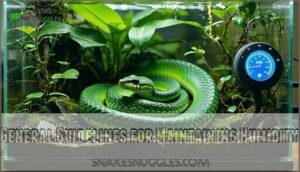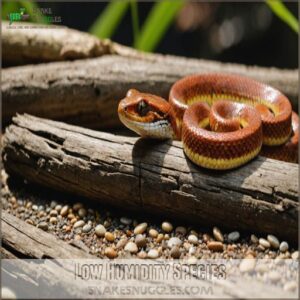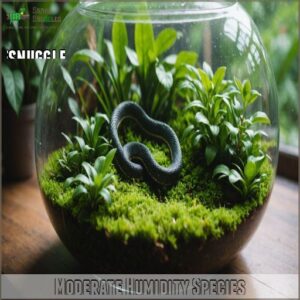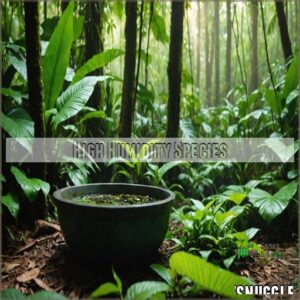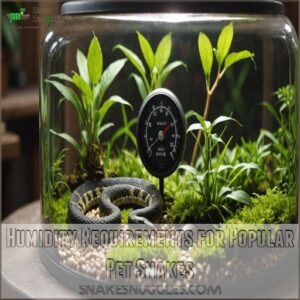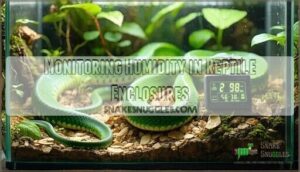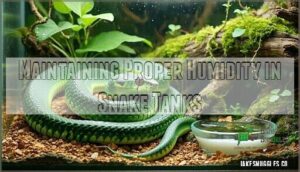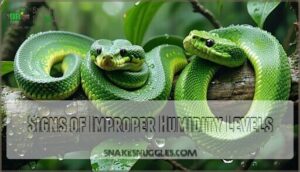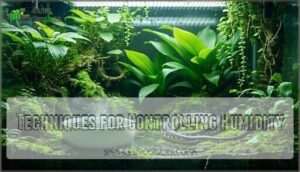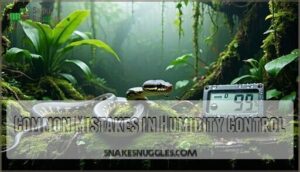This site is supported by our readers. We may earn a commission, at no cost to you, if you purchase through links.
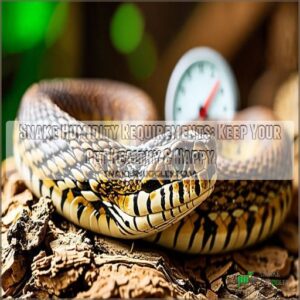
Different snakes hail from diverse habitats, so their humidity needs vary.
For instance, tropical snakes like ball pythons thrive in 50-60% humidity, while desert types, such as corn snakes, prefer a drier 30-40%.
A trusty hygrometer keeps you in the loop, ensuring you’re not giving your snake a climate shock.
Keep water fresh and the substrate moisture-retentive to help skin shedding go smoothly.
Remember, humidity isn’t just for the flora; your snake needs it too!
Curious about more humidity hacks for your scaly friend? Stay tuned!
Table Of Contents
- Key Takeaways
- Humidity’s Crucial Role in Snake Health
- General Guidelines for Maintaining Humidity
- Humidity Requirements by Snake Species
- Monitoring Humidity in Reptile Enclosures
- Maintaining Proper Humidity in Snake Tanks
- Signs of Improper Humidity Levels
- Techniques for Controlling Humidity
- Common Mistakes in Humidity Control
- Frequently Asked Questions (FAQs)
- What is the ideal humidity level for temperate snakes?
- Do snakes need humidifiers?
- Do snakes need humidity?
- How to control humidity levels for pet snakes?
- What is the ideal temperature range for a ball python’s habitat?
- How should I create a temperature gradient in my ball python’s enclosure?
- Can I use heat lamps to provide warmth for my ball python?
- How important is maintaining proper humidity for ball pythons?
- Should I use UVB lighting in my ball python’s enclosure?
- How can I ensure safe temperatures for my ball python’s enclosure?
- What is the best humidity for snakes?
- Is 80 humidity too high for ball pythons?
- Is 50% humidity okay for a ball python?
- Is too much humidity bad for a snake?
- How often should I mist my snakes enclosure?
- What substrate is best for humidity control?
- Can I use a room humidifier for my snake?
- My snake isnt shedding properly; whats wrong?
- How do I know if the humidity is too high?
- Conclusion
Key Takeaways
- You must monitor humidity levels daily using a digital hygrometer to ensure your snake’s health.
- Different snake species require different humidity levels; research your snake’s specific needs.
- Maintain proper humidity to prevent shedding problems, respiratory issues, and dehydration.
- Use a combination of water bowls, damp substrate, and misting to achieve and maintain the correct humidity.
Humidity’s Crucial Role in Snake Health
You might think keeping your snake’s humidity just right sounds tricky, but it’s easier than explaining why your pet needs sunglasses.
Proper humidity helps your snake shed its skin comfortably and breathe easily, much like you rely on your favorite fluffy socks and fresh air.
Maintaining Proper Humidity Levels
Maintaining a proper environment with good tank ventilation, as seen in a snake health checklist Creating a Healthy Environment, ensures the right humidity levels keeps your snake happy and healthy.
You’ll want to use a digital hygrometer for accurate humidity monitoring.
From the right substrate choices like cypress mulch to proper enclosure ventilation, every element counts.
Avoid humidity control mistakes by tailoring settings to your snake species’ needs, ensuring the right balance in your snake enclosure humidity.
Impact of Improper Humidity on Snakes
After grasping the basics of maintaining humidity, it’s essential to understand the risks of getting it wrong.
Incorrect humidity levels can lead to dehydration and respiratory issues like infections, leaving your snake wheezing.
Shedding problems and skin infections are also common, potentially leading to serious organ damage.
Ensuring proper humidity levels safeguards your snake’s health and comfort.
Importance of Humidity for Shedding and Hydration
Proper humidity prevents shedding problems.
Dry skin leads to stuck sheds, causing infections.
Dehydration risks increase with low humidity; provide fresh water daily.
By understanding the importance of snake hydration, you can better recognize the warning signs of dehydration.
Maintaining proper humidity levels is crucial for your snake’s health, as low humidity can lead to dry airways, discomfort, and dehydration, while high humidity can increase the risk of respiratory infections, so ensure you’re meeting your pet’s specific humidity needs to avoid these issues.
Regular misting and a large water bowl are simple hydration methods.
Monitoring humidity levels is key for snake health.
You’ll prevent dehydration and guarantee healthy shedding.
Humidity’s Effect on Snake Respiration
Your snake’s humid environment greatly impacts its respiratory function.
Low humidity levels can irritate delicate respiratory tissues, leading to infections and discomfort.
Maintaining good snake enclosure humidity ensures good air quality, reducing respiratory infections.
Adequate ventilation is essential, just like a well-cooked meal needs the right seasonings.
Keep an eye on humidity levels to safeguard your snake’s health and well-being.
General Guidelines for Maintaining Humidity
To keep your scaly friend happy and healthy, you need to maintain the right humidity in their enclosure by understanding relative humidity, choosing an appropriate setup, and measuring levels accurately.
This way, you can avoid a snake that’s as cranky as a dehydrated grape by using methods like misting or adding water dishes to increase humidity.
Understanding Relative Humidity
Understanding how relative humidity impacts your snake’s health is like holding the key to their happiness.
It measures the air’s moisture compared to its maximum capacity.
Using digital hygrometers helps you nail this down with precision, and you can find the right tools for this, such as a snake humidity gauge, to get started.
Keep monitoring these humidity levels to make sure your pet is comfortably shedding, breathing, and staying hydrated.
It’s all about mastering that balance!
Locating a Suitable Enclosure
Locating the right enclosure plays a big role in maintaining the best humidity for your snake.
Choose an enclosure size that suits the snake species, ensuring good ventilation and using materials like glass or acrylic to retain moisture.
Consider the heating setup to aid humidity control.
This thoughtful snake enclosure setup mimics their natural habitat, keeping your slippery friend happy and healthy.
Measuring Humidity Levels
Imagine this: you’ve got a snake, and you’re wondering if it’s cozy enough.
Use digital hygrometers for accurate readings of humidity levels in your snake’s habitat.
Hygrometer accuracy is essential, so focus on proper humidity calibration.
Perfect enclosure placement helps meet your snake species’ specific humidity needs.
Remember, a well-placed hygrometer keeps humidity monitoring smooth and effective.
Methods for Increasing Humidity
Accurate humidity measurements set the stage for effective humidity control.
To boost humidity, try larger water bowls or select moisture-retaining substrates like cypress mulch.
Misting frequency matters; aim for daily misting to maintain ideal humidity levels.
To maintain a clean habitat and prevent bacterial and parasite growth, it’s essential to clean the snake’s enclosure every two to three days as part of snake health maintenance learn more about snake health issues. Integrating humidifiers or reptile foggers can also help, but balance with adequate ventilation control to prevent over-humidification and guarantee your snake’s health.
Humidity Requirements by Snake Species
Now that you understand the general principles of humidity control, let’s explore the specific needs of different snake species.
Each type of snake, including the boa constrictor which requires maintaining humidity levels between 55-75% for skin shedding and respiratory health using humidity control devices, requires a particular humidity range for ideal health, so learning these specifics is essential for your pet’s well-being.
Low Humidity Species
Think your snake’s got a dry sense of humor? Some low humidity species, like corn snakes, flourish at 30%-50% humidity. Keep your ball python comfy between 50%-60%. Kingsnakes prefer 40%-60%. They don’t need a tropical vacation—just a well-tended water dish and maybe a misting. Watch out for shedding issues; they’re the humidity hint!
- Choose low humidity substrate
- Keep snake species-specific standards
- Monitor humidity levels carefully
Moderate Humidity Species
So, you’ve mastered low humidity species; now let’s tackle moderate humidity champs.
Red-tailed Boas need 60-70% humidity, while Milk Snakes prefer 40-60%.
Add moisture-retaining substrates to keep them happy.
A Kingsnake loves it a tad dry, maintaining 40-60% with consistent humidity control is key.
| Snake | Humidity (%) |
|---|---|
| Red-tailed Boa | 60-70 |
| Milk Snake | 40-60 |
| Western Hognose | 30-40 |
| Kingsnake | 40-60 |
High Humidity Species
Moving from moderate to high humidity species, Green Tree Pythons and Emerald Tree Boas need moist environments.
Aim for humidity levels of 70-90% to aid shedding and prevent disease.
You can create a humid environment by using a reptile fogger to mist their enclosure regularly.
Keep your snakes happy with a big water bowl and regular misting.
It’s like the rainforest in your living room, ensuring your snakes feel at home while you monitor conditions using a hygrometer.
Humidity Requirements for Popular Pet Snakes
Apart from high humidity species, many pet snakes like Corn Snakes, Ball Pythons, and Kingsnakes have their own species-specific humidity needs.
Get your enclosure setup just right to meet these unique requirements.
Use monitoring tools to make sure your reptile’s habitat provides the best conditions.
Avoid common mistakes that could affect your snake’s health through proper humidity control, ensuring comfort and well-being.
Monitoring Humidity in Reptile Enclosures
Monitoring the humidity in your reptile enclosure is as important as keeping track of your favorite TV show’s new episodes, and it’s easy with the right tools.
Digital hygrometers give you accurate readings, ensuring your snake always has the best environment to stay healthy and happy.
Tools for Monitoring Humidity
After nailing down humidity needs for different species, it’s all about having the right tools to keep environments stable.
Here’s what you’ll need:
- Digital Hygrometers: They offer precise humidity levels.
- Calibration Methods: Make sure your hygrometers are accurate with regular checks.
- Placement Tips: Place tools centrally to get reliable readings.
Maintain these to prevent your snake’s health from going south!
How to Use Monitoring Tools
Let’s get started using your humidity and temperature monitoring tools! First, you’ll want to calibrate your tools for accurate readings. Regular calibration helps ensure Hygrometer Accuracy.
Then, note the Monitoring Frequency – daily checks are ideal.
Record your data diligently. This helps you track trends and make sure you have the right conditions for your snake species.
| Tool | Action |
|---|---|
| Hygrometer | Check humidity levels daily. |
| Thermometer | Monitor temperature twice daily. |
| Data Log | Record readings consistently. |
| Calibration Kit | Calibrate tools monthly, as needed. |
Placement of Monitoring Tools
Finding the sweet spot for placing your hygrometer is key to keeping your snake’s environment perfect.
Aim for the enclosure’s center, avoiding corners where readings might be off.
Size matters, so larger enclosures may need multiple tools for accuracy.
With consistent monitoring frequency and well-chosen locations, you’re on track for ideal temperature measurement and environmental control in your reptile environment.
Maintaining Proper Humidity in Snake Tanks
To keep your snake healthy and happy, you need to maintain the right humidity in its tank by using a suitable water source and moisture-retaining substrates.
Installing humidity aids and creating a temperature gradient can further enhance your enclosure’s environment.
Providing a Suitable Water Source
How can you make sure your snake stays hydrated and humidity levels are just right?
Start with the right water bowl size, allowing your snake species to comfortably drink.
You can find a variety of snake water bowls online at stores like Snake Water Bowls.
Place the water source thoughtfully to boost enclosure humidity.
Regular water changes maintain water quality, reducing dehydration risks.
Choose water dish types that suit your setup, making sure reptile care remains excellent.
Use of Moisture-retaining Substrates
Selecting the right substrate types can be your secret weapon in managing humidity levels for snake care.
Coconut husk, sphagnum moss, and cypress mulch excel at substrate impact and moisture retention.
Make sure to provide a proper substrate depth to create a cozy environment.
Regular substrate maintenance and changes help with reptile care tips but also prevent pesky mold and bacteria, keeping your snake species healthy.
Installing Humidity/Hydration Aids
Installing humidity aids can be a game changer for your snake’s habitat.
Options like humidifiers and foggers help maintain ideal humidity levels**, essential for proper snake husbandry.
To make sure you’re targeting the right humidity range, research the specific humidity needs of your snake species, such as ideal humidity levels for different species.
Consider the size of the enclosure when placing these tools.
Misting frequency also matters—too often, and it’s a swamp; too little, and it’s a desert!
Keep an eye on humidity levels for snake health tips.
Creating a Temperature Gradient
So you’ve mastered installing humidity aids; now, let’s talk about creating a temperature gradient for your snake.
Place heat lamps or mats on one side of the enclosure to set up a cozy warm area.
Make sure the cooler side is inviting too.
This gradient helps maintain proper humidity levels, promoting snake health.
It’s a balancing act that requires attention to detail!
Signs of Improper Humidity Levels
You’ll notice problems like difficulty shedding, respiratory infections, or dehydration if your snake’s humidity is off.
These symptoms, ranging from minor skin issues to serious illness, are key indicators requiring immediate attention and humidity adjustments.
Dehydration Symptoms
After checking if your snake tank’s humidity is just right, look out for dehydration symptoms.
Watch for these telltale signs:
- Lethargy and lack of appetite might signal low humidity levels.
- Sunken eyes and dry skin indicate dehydration symptoms in pet snakes.
- Mouth breathing suggests more than just bad breath—it hints at reptile health issues.
These guide your snake care efforts!
Respiratory Issues
Ever notice your snake wheezing or having labored breaths?
That’s a red flag for respiratory problems, often linked to improper humidity levels in its enclosure.
As a snake owner, you’ve got to maintain the right humidity to prevent these issues.
Use a digital hygrometer to monitor humidity levels, ensuring your pet’s health and reducing respiratory issues effectively.
Skin and Shedding Problems
Sometimes your snake might struggle with shedding difficulties due to improper humidity levels, which can lead to issues like retained eye caps or constricted shedding around body parts.
You’ll notice stuck sheds, dry skin, and skin infections.
Keep an eye out for signs like hydration issues, which can lead to serious skin problems, such as dull coloring and cloudy eyes.
Unchecked humidity issues could even encourage bacteria or mold growth.
Regularly adjust humidity to support a smooth shedding process and avoid these pesky problems.
Techniques for Controlling Humidity
To maintain the right humidity for your snake, consider using a combination of water bowls, damp substrates, and misting systems.
With a little effort and some clever tricks, you’ll create a cozy home that replicates your pet’s natural habitat perfectly.
Using Water Bowls and Damp Substrate
Notice your snake’s shedding seems off.
Adjusting humidity can help, and water bowls and damp substrates are key.
Choose the right water bowl size and place it on the warm side to boost evaporation.
To avoid issues like scale rot and respiratory problems, it’s important to monitor and manage lower humidity in the snake tank.
Select substrate types wisely; cypress mulch and coconut fiber work wonders.
Make sure the substrate depth is right for effective humidity control in your pet snake’s environment.
Utilizing Humidifiers or Mist Systems
Keeping humidity levels in check is easier with humidifiers or mist systems.
These handy gadgets offer a steady mist, perfect for snake enthusiasts juggling busy schedules.
Choose a humidifier that matches your enclosure size and misting frequency needs.
Regular snake enclosure maintenance, including proper substrate choice like aspen shavings, coconut husk, or newspaper for optimal snake care, guarantees reliable humidity control, keeping your pet snake in tip-top shape and avoiding pesky reptile husbandry challenges.
Strategies for Increasing or Decreasing Humidity Levels
Humidifiers aren’t always the answer; sometimes, you need to fine-tune things.
To boost humidity, consider these:
- Adding more water sources.
- Switching to a moisture-retentive substrate.
- Decreasing ventilation.
Conversely, to lower humidity, increase ventilation, use a dehumidifier, or reduce the size of your water dish.
Remember, consistent monitoring is key!
Common Mistakes in Humidity Control
You might think keeping your snake’s habitat humid sounds easy, but even experienced owners can make common errors.
Misjudging humidity levels, forgetting to monitor, or neglecting a temperature gradient can leave your slithery friend less than thrilled.
Inadequate Monitoring
A common pitfall in reptile care is overlooking consistent humidity monitoring.
You might set everything up perfectly, but if you forget to check regularly, humidity fluctuations can sneak up, affecting your snake’s health.
For accurate readings, make sure your thermometer is correctly placed.
Don’t skimp on monitoring frequency; like clockwork, it helps prevent health complications, supporting your pet’s overall well-being.
Insufficient Humidity
Ignoring your snake’s humidity needs can lead to serious issues.
Dehydration, shedding problems, and even respiratory or skin issues are potential risks.
For snakes like ball pythons, a consistent humidity level is essential.
Miss this step, and it could be organ damage next.
Always check your red-tailed boa constrictor’s environment with a reliable hygrometer to make sure their health is good.
Excessive Humidity
Insufficient humidity can be a problem, but excessive humidity isn’t your buddy either.
Watch for mold growth and fungal infections.
Prolonged high humidity can lead to:
- Respiratory issues
- Skin problems
- Stagnant air due to poor ventilation
- Increased stress levels in snakes
- Unwanted fungal growth
Tweak your herpetoculture skills to keep humidity levels in check!
Failure to Provide a Temperature Gradient
While tackling excessive humidity, consider the importance of creating a temperature gradient in your snake’s enclosure.
Failing to do so can lead to temperature shock and uneven heating, directly affecting your pet’s stress levels and overall health.
To maintain optimal humidity levels, it’s essential to monitor and adjust the environment according to your snake’s specific needs, especially when it comes to humidity control strategies. Use thermostats and heat sources wisely to balance humidity levels and provide snake environment tips for effective enclosure design.
Frequently Asked Questions (FAQs)
What is the ideal humidity level for temperate snakes?
For temperate snakes like corn snakes and kingsnakes, aim for a humidity level between 40% and 60%.
This range supports their natural shedding process and overall health, ensuring they stay comfortable and thrive in their habitat.
Do snakes need humidifiers?
Snakes might need humidifiers, especially in drier climates, to maintain healthy humidity levels in their enclosures.
By ensuring the right moisture, humidifiers help prevent dehydration, shedding issues, and respiratory problems, supporting their overall well-being.
Do snakes need humidity?
Picture a snake’s enclosure as a mini rainforest.
Snakes need humidity to thrive, aiding in shedding, hydration, and health.
Without proper moisture, they face risks like poor shedding and respiratory issues.
Keep their environment balanced and safe.
How to control humidity levels for pet snakes?
Keep your snake comfy by using a digital hygrometer to monitor humidity, adjusting with misting, water dishes, or humidifiers.
A suitable substrate, like coconut fiber, also helps maintain moisture.
Regular checks prevent issues like dehydration or respiratory problems.
What is the ideal temperature range for a ball python’s habitat?
Your ball python’s cozy corner needs a temperature range of 75-80°F on the cool side and 85-90°F on the warm side.
This gradient lets them thermoregulate effectively, promoting healthy digestion and metabolism without a hitch.
How should I create a temperature gradient in my ball python’s enclosure?
Get a heat lamp or heat mat for one side of the enclosure to create a warm zone.
Use a thermostat to maintain temperatures around 85-90°F, while keeping the cooler side at 75-80°F.
Can I use heat lamps to provide warmth for my ball python?
When setting up a terrarium for your ball python, understanding the importance of a thermal gradient, such as the snake heat lamp requirements, is crucial for their health and well-being. Like a sun warming a desert, heat lamps can indeed warm your ball python.
However, make sure a cool side too; they need a temperature gradient for comfort and health.
Use a thermostat to prevent overheating.
How important is maintaining proper humidity for ball pythons?
Maintaining proper humidity for ball pythons is essential to their well-being.
It helps with shedding, respiration, and hydration.
Maintaining proper humidity levels is essential to facilitate a smooth shedding cycle and prevent skin issues, such as those caused by snake fungal disease prevention. Aim for 50% to 60% humidity to prevent health issues and create a comfortable environment for your snake.
Should I use UVB lighting in my ball python’s enclosure?
Imagine a ball python soaking up sunlight like a tiny sunbather!
While UVB lighting isn’t necessary for ball pythons, offering it can support overall health and well-being, especially bone health, if you choose to use it.
How can I ensure safe temperatures for my ball python’s enclosure?
Ball pythons require a specific temperature range and humidity level to thrive, and maintaining the ideal humidity level between 60-70% is crucial, you can learn more about creating this environment with a suitable ball python enclosure. Make sure your ball python’s enclosure has a temperature gradient, with a warm side at 85-90°F and a cool side at 75-80°F.
Use heat lamps or mats with thermostats.
Regularly monitor with a digital thermometer.
What is the best humidity for snakes?
The best humidity for snakes depends on the species, typically ranging from 30% to 90%.
To keep their skin and lungs healthy, consult specific needs: corn snakes like 30%-50%, while emerald tree boas need 80%-90%.
Is 80 humidity too high for ball pythons?
Eighty percent humidity is indeed too high for ball pythons.
They thrive in a range of 50% to 60%.
You should reduce moisture levels to prevent respiratory issues and keep your snake healthy and comfortable.
Is 50% humidity okay for a ball python?
Ball pythons thrive in humidity levels between 50% and 60%.
So at 50%, you’re hitting the sweet spot.
Just keep an eye on it with a hygrometer to make sure it’s consistently within their ideal range.
Is too much humidity bad for a snake?
Did you know that excessively humid environments can cause respiratory infections in snakes?
Yes, too much humidity is detrimental; it promotes bacterial and fungal growth, potentially harming your snake’s health.
Maintain proper ventilation and monitor humidity levels closely.
How often should I mist my snakes enclosure?
You should mist your snake’s enclosure at least once a day to maintain proper humidity levels.
Regular misting prevents dehydration and shedding issues, ensuring your scaly friend stays comfortable and healthy in its habitat.
What substrate is best for humidity control?
Cypress mulch, coconut husk, and sphagnum moss are top choices for humidity control in snake enclosures.
These substrates naturally retain moisture, helping maintain ideal humidity levels.
They also resist mold growth, ensuring a healthier environment for your snake.
Can I use a room humidifier for my snake?
Imagine your snake’s vivarium like a tiny rainforest, where humidity is key for comfort.
Using a room humidifier can help, but monitor levels closely and adjust to avoid turning the habitat into a marshland.
My snake isnt shedding properly; whats wrong?
Improper shedding in snakes often stems from low humidity or dehydration.
Check for sufficient enclosure moisture, using tools like hygrometers and misting, and make sure they’re properly hydrated.
Adjust these elements to help your snake shed comfortably.
How do I know if the humidity is too high?
Check for condensation building up on enclosure walls or mold growing on substrates, as these signs suggest high humidity.
Use a digital hygrometer to measure and make sure humidity aligns with your snake’s specific requirements, keeping it balanced.
Conclusion
Think of snake humidity requirements like tuning a musical instrument; precision matters.
Your snake’s health hinges on maintaining the right humidity balance.
Keep an eye on those hygrometers to avoid climate missteps.
Whether it’s shedding smoothly or breathing easy, the right humidity is key.
Avoid common pitfalls like inadequate monitoring or improper substrate use.
By understanding your pet’s specific needs, you create a habitat where they can thrive comfortably and healthily, like a well-tuned orchestra of reptilian bliss.


